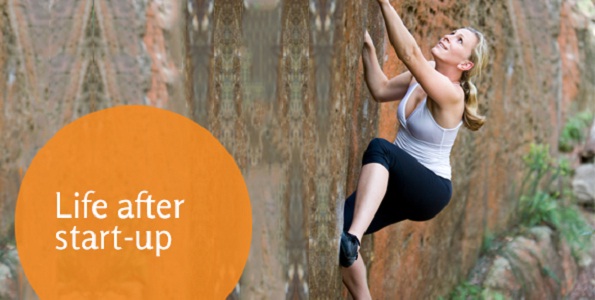Life after start-up
On May 9 I’ll be in Queensland, presenting at Toowoomba’s annual Innovation, Leadership and Strategy Summit. The blurb in the conference program says I’ll be taking participants through ‘my strategy in getting my vision to ‘land’ in reality, overcoming obstacles and moving from a start-up to successfully signing multi-national deals.’
If it were only that simple! The program makes it sound as if I had a clear, detailed plan, which – apart from the odd speed bump – worked out just as I wanted. The reality’s far messier, and much more exciting. So, now that Springday’s beyond start-up and poised to become big business, here’s what actually happened and where we’re at today.
First, I did have a vision. It sprang from my twin passions, wellbeing and technology. (And I do mean passions. I’m not using the word lightly). I’d worked in the corporate world and I thought of – and started to read about – a new paradigm for human resources, one where instead of dealing with staff after they became ill or had wellbeing problems, we could support their wellbeing in the first place.
The challenge was how to deliver cost-effective wellbeing programs flexible enough to meet individual, divisional and company needs. My solution was to develop a technology platform and use it to drive an infinitely flexible virtual wellbeing arm for global business. I launched the platform in 2009 and our first big site, for AGL, was launched in 2012.
Did you notice the gap between 2009 and 2012? Three years. I can’t pretend they were easy. There were long hours, late nights and an enormous amount of stress. The picture above tells the story: I often felt as if I was scaling a sheer rock face one foot and handhold at a time, inching towards a goal but only millimetres away from falling. My obstacles included money worries, near-sighted CEOs and, if I’m being honest, the difficulty of being taken seriously as a younger woman with a baby, who doesn’t code, in a tech world.
On the plus side, I have an appetite for risk in both physical (I love sailing and rock climbing) and personal senses. And a very supportive family. Most of all, however, I believe in my vision. A couple of times I could have taken money for a compromised result but I stuck to my guns and slowly, slowly the market opened up. To cut a long story short, today Springday has 25 live platforms, with 5 more going live as I write.
But that’s only half the story. I knew that my area was changing fast and I so kept an eye on the scene. What I hadn’t bargained for was the rate of change. In 2009 smartphones and app stores were in their infancy. There weren’t even wearables. Today they’re everywhere. In fact, rumours suggest wearables are at 20% deployment across Australia.
The point is that things in the tech world change faster than any strategy. If there’s one lesson to take from this, it’s to have a strong foundation so you can change direction, fast. Springday has three strengths: first, our platform can be integrated with smart devices, wearables, and whatever comes next. We’re currently scoping our first single-sign-on for a client to improve user experience, which means no more confusing lists of passwords. Second, Springday incorporates and collates measurable data and this is proving invaluable to both users and managers. And third, our team believes in what we do, and is committed to the success of Springday.
The Springday platform has applications stretching far beyond the corporate world. We’ve recently launched our first fitness platform with Willows Health and Lifestyle Centre to bring the wellbeing hub to fitness centres, and we have plans for many more. Willows’ Troy Morgan recently presented at the Australian Health and Fitness Expo in Melbourne and was mobbed by people interested in our platform. Our mobile wellbeing platform will give fitness centre members a choice: to go to the gym or take the gym with them, everywhere, in their pockets! (Here, by the way, is a link to a short clip about what Springday can do for fitness centres)
Also, and this makes me very proud, the Springday platform’s being trialled for use in healthcare, for patient recovery. Chris O’Brien Lifehouse patients will access the platform and record activity, sleep, pain, mood, fatigue, and other rehab activities. Doctors will monitor this information and target follow-up to those patients most in need.
So, where is Springday now? As I said, we’re growing in the corporate world and expanding into fitness and healthcare. And as we grow, we’re attracting investors. So I’ve sold 10% of Springday to a channel partner.
We’re also solidifying our e-learning capabilities and our reporting. We’re working on new and better challenges. We’re partnering with global wearable brands to offer our wellbeing apps across the world. We’re pursuing artificial intelligence (AI) data analytics with an awesome tech CEO from Hyper, Anna, Natalie Nguyen, to help us secure our data management and mining capacity – in fact, we’re in the market for a doctoral fellow to manage data analysis for us.
So Springday’s well beyond start-up. The future looks good. It isn’t easy and it isn’t predictable but oh boy, it’s one hell of a ride. I’m looking forward to you joining me on this journey.
What’s going on
We feel we’ve been bombarding you with too many links, so we’ve cut them back. If you disagree and want more, let us know by emailing info@myspringday.com.au.
Meanwhile, here are some interesting articles we came across in April:
Most inspiring people of 2016? Every year, the Schwab Foundation announces the world’s top social entrepreneurs – that is, people who use their business expertise to make the world a better place. Here’s Schwab’s list of award winners for 2016.
Healthy buildings are important, too: we think of wellbeing in terms of people, not buildings. But if the places we work in are sick, they’ll make us sick as well. We already expect our workplaces to be green, our desks adjustable…the next step is to involve doctors in building design. Read on…
Top 10 gamification case studies: not sure how gamification works to aid learning? These studies point the way to gamification’s future.
Critical things ridiculously successful people do every day: Kevin Kruse asked more than 200 major over-achievers the question ‘What is your number one secret to productivity?’ Here are some of his findings.
How our brains fool us: we might think we’re rational and logical but closer examination reveals our brains are subject to all sorts of quirky influences. For example, an Israeli study found the rulings of judges were affected by…lunch. This is a fascinating look at our temperamental minds.










